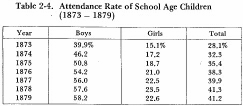- 現在位置
- トップ > 白書・統計・出版物 > 白書 > JAPAN'S MODERN EDUCATIONAL SYSTEM > a. The Establishment of Elementary Schools and Attendance
a. The Establishment of Elementary Schools and Attendance
After the government abolished the prefectural schools, country schools (gogakko), terakoya and private schools (shijuku) with the enforcement of the Education System Order, it began to establish new institutions. The government also accepted applications from private groups who wished to open their own schools. Official recognition and permission to operate a school was granted in accordance with Chapter 43 of the Education System Order, and top priority was given to the organization of elementary education. Indeed, as far as the prefectures were concerned, practically the entire effort toward implementing the Education System Order was concentrated in elementary education. By 1875, 24,303 elementary schools had been opened with a total enrollment of 1,926,126 pupils (See Table 2-3.). This constituted a 35.4% rate of attendance (50.8% of the boys and 18.7% of the girls of school age) (See Table 2-4.). Thereafter both the number of children attending school and the rate of attendance increased. Tables 2-3 and 2-4 show the scale of the school system and school attendance percentages for children of school age during this early period.
Although the establishment of elementary schools under the Education System Order spread rapidly throughout the country, initially many of the schools were indistinguishable from the country schools, terakoya and private schools of the former era. By way of example, in taking up the question of school buildings as they existed in 1875, we find that approximately 40% of the total were structures leased from Buddhist temples and 30% were leased from private individuals. Also the great majority of these schools had at most one or two teachers with classes of from forty to fifty pupils. But with the construction of new school buildings, the increase in the number of children attending schools, larger teaching staff and better qualified teachers, a modern elementary educational program gradually came into being.
Table 2-3. Elementary School Figures (1873-1879)

Table 2-4. Attendance Rate of School Age Children (1873-1879)

In connection with this was the urgent matter of attendance expected for school-age children. In accordance with the spirit of the Education System Order, each prefecture adopted the policy of encouraging attendance at school. School district supervisors and other persons connected with schools in towns and villages exerted considerable effort to see that all concerned were properly enrolled in school. But enforcement of this rule on the general public was no easy task.
While it was true that by the last years of the Shogunate, the terakoya and private schools had spread to rural and mountain communities throughout Japan, the number of children actually enrolled in these institutions was rather small. Moreover, many children remained in attendance only for a short time learning nothing more than the very basic elements of reading, writing and abacus calculation. Generally speaking, the ordinary person saw almost no necessity for school education. Naturally there was a wide gap between the view of modern education held by the proponents of the Education system Order and the opinion of the common folk.
A discrepancy was also evident in the sex ratio of children attending school. In 1873, the ratio for boys was 39.9% and for girls 15.1% (See Table 2-4.). Most ordinary people believed that modern education for girls was not only a waste of time but potentially harmful.
These negative feelings toward modern education were especially deep-rooted in rural and remote localities as is reflected in percentages of school attendance for different prefectures. In 1877 for the entire nation the percentage of children of school age who attended classes was 39.9%. But by locality there was a considerable range from a high of 67.1% in urban Osaka Prefecture to a low of 22.6% in rural Aomori Prefecture. Moreover based on the scanty data that is available it would appear that most children only attended the lowest grade of the elementary school. For example, in 1875, children enrolled in the first semester of the lower division of the elementary school constituted roughly 65% of the total school enrollment. Second semester pupils accounted for about 17% and from the third semester up there was a marked decrease. Two years later the percentages stood at about 49% for the first semester and about 19% for the second. Enrollment in the upper division of the elementary school was 0.8% of total enrollment.
お問合せ先
(C)COPYRIGHT Ministry of Education, Culture, Sports, Science and Technology
-- 登録:平成21年以前 --